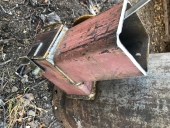





Beck Protocol for health
 4
4




 2
2




Beck Protocol for health
 1
1



















Fox James wrote:If you are looking for lightness and ease of build then you may care to look at the 5 min riser system.
If a 5 minute riser suits you, then you might as well make a 6” system as the weight saved will be substantial.
Beck Protocol for health




Phil Stevens wrote:Slip is a runny mixture of clay and water. You want just enough to coat the perlite and help it stick together, not fill all the voids and make a massive riser.
Beck Protocol for health















Phil Stevens wrote:Hi Joe - my experience with fireclay slip and waterglass has been that I can get a nice low-viscosity mixture that works well for coating perlite. My error when I cast the first riser was simply using too much of it, and not only did it slump badly, but it took weeks to dry out and now acts more as mass than insulation. When I refashion the RMH after this winter, I will rebuild the burn tunnel and make a five-minute riser.
Beck Protocol for health




Roberto pokachinni wrote: I did read about someone using fibreglass.
I was thinking about doing this as well. My thoughts on this: The fibers might be small, but that is not a bad thing, as you are looking for micro re-bar. They will bind bit by bit throughout the mix. Wear a mask. Mix them into your dry mix so that you get them evenly distributed, and then add your water. Make a mix of just the fiberglass fibers (in higher quantity with clay slip) and run that over the internal surface to give it super strength.
Beck Protocol for health











 2
2




Joe Moon wrote:
Fox James wrote:If you are looking for lightness and ease of build then you may care to look at the 5 min riser system.
If a 5 minute riser suits you, then you might as well make a 6” system as the weight saved will be substantial.
I have looked around for a "5 minute riser" and can't find anything on it.
If I'm going to consider it I will need to know what it is, what it does and how to make one.
It would be handy if there was a thread about it.




Beck Protocol for health




Beck Protocol for health
 2
2




Joe Moon wrote:
This first stove I'm building is not a heater, its for camping. Its more of an experiment...

 1
1








Fox James wrote:Ok Joe you must do what ever you want but I am a Little confused with your design?
As I am sure you know, metal inside the fire box and heat riser will not fair well over time, for occasional use some metal will last but tin cans will degrade very quickly
A steel tube lined on the inside with insulation with be very strong but a perlite and clay riser will be quite fragile.
There are lots of potable “steel construction” rocket stoves on YouTube (hundreds possibly) but without insulation I am not sure how effective they are at heating large containers or how long they will last.
Rocket stoves are most efficient when correctly sized and very well insulated, you can expect very hot temperatures above the heat riser around 500c or more.
From my own experiences using, perlite and vermiculite, the end results are never very strong. The more binder you use ie clay, cement, fondu etc the stronger but less insulating the end result will be.
Fine if the riser is left inside a barrel and left alone but not so good if it will be moved around, the ones I have built would most certainly fracture if allowed to fall over!
For casting purposes you may find cardboard tube is very good and of course will burn out , any carpet suppler with have empty 4” 6” and 8” cardboard tubes.
Do you have problems importing from England, I live in Guernsey but buy my ceramic products from Wales!
Beck Protocol for health








Fox James wrote:Ok well good luck with your build and please keep us informed as to how it all works out.

Beck Protocol for health




Burl Smith wrote:
Since the draft will go up the riser once started, you could cast the pieces separately to be assembled at camp, adding maybe a sturdy A-frame support bracket that could double as the pot stand.
Beck Protocol for health

|
I just had the craziest dream. This tiny ad was in it.
The new permaculture playing cards kickstarter is now live!
https://www.kickstarter.com/projects/paulwheaton/garden-cards
|





